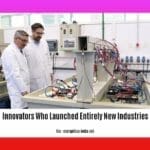Get ready to embark on a journey through the annals of travel and transit innovation with “Pioneers Who Revolutionized Travel and Transit: Stories of Visionaries and Innovators.” Join us as we unveil the tales of extraordinary individuals whose groundbreaking ideas transformed the way we explore the world. From the Wright brothers to Elon Musk, these pioneers dared to dream big, pushing the boundaries of technology and imagination. Their stories are a testament to the human spirit’s unwavering pursuit of progress and connectivity.
Key Takeaways:

- Trains revolutionized transportation, enabling efficient long-distance travel.
- The 19th century saw major advancements in railways, urban transit, and road infrastructure.
- Improved roads and turnpikes, such as the Cumberland Road, reduced travel costs and increased mobility.
- Travel became faster and more affordable between 1790 and 1840.
Pioneers Who Revolutionized Travel and Transit
In the annals of transportation history, there are unsung visionaries and pioneers who revolutionized travel and transit, transforming our ability to traverse the globe. They dared to dream of a world more connected and accessible, forever etching their names in the annals of progress.
The Dawn of Railways
The invention of trains marked a pivotal moment in transportation history, enabling people and goods to traverse vast distances with unprecedented speed and efficiency. Before the advent of the steam locomotive, travel was arduous and time-consuming. But inventors like George Stephenson and Richard Trevithick spearheaded a transportation revolution.
The Urban Revolution
In the 19th century, urban areas swelled with populations eager to move about. This demand spurred the development of urban transit systems like horse-drawn streetcars and elevated railways. These innovations eased congestion and made cities more livable.
The Road to Progress
The widespread construction of roads and turnpikes, such as the Cumberland Road, facilitated travel and reduced transportation costs. These improvements allowed farmers to reach markets more efficiently, fostered commerce, and connected communities.
The Power of Innovation
Transportation advancements were driven by a spirit of innovation and relentless pursuit of progress. Inventors like John Cadogan, who revolutionized road construction techniques, and Thomas Telford, known for his innovative suspension bridges, exemplify the ingenuity that reshaped travel.
The Legacy of Visionaries
The pioneers who revolutionized travel and transit left an enduring legacy. Their inventions and ideas transformed the way we explore the world, commute to work, and connect with one another. From the steam locomotive to the modern high-speed rail, their contributions continue to shape our present and inspire our future.
The innovators who transformed transportation and mobility are the pioneers behind many of the breakthroughs that have made our world more connected and accessible. From the invention of the wheel to the development of the automobile, transportation pioneers have pushed the boundaries of what is possible. Their landmark innovations have shaped the way we live and work, and continue to inspire new generations of innovators.
Safety Enhancements Protected Travelers and Commuters
Throughout history, safety has been a paramount concern in the realm of travel and transportation. As pioneers pushed the boundaries of innovation, they devised ingenious ways to safeguard the lives and well-being of travelers and commuters.
Innovations That Transformed Safety
- Horse-Drawn Streetcars: These early modes of urban transit featured brakemen who used levers to control the car’s speed and stop it swiftly.
- Elevated Railways: By elevating tracks above street level, these systems reduced the risk of collisions with vehicles and pedestrians.
- Motor Coaches: The advent of motor coaches brought with it improved suspension systems, which enhanced passenger comfort and reduced the likelihood of accidents.
- Traffic Lights: The introduction of traffic lights at intersections created a more organized and predictable flow of vehicles, minimizing the risk of collisions.
- Seatbelts: This simple yet life-saving device has become ubiquitous in modern vehicles, significantly reducing the severity of injuries in the event of a crash.
Key Takeaways:
- Safety has always been a driving force in transportation innovation.
- Advances in technology and engineering have played a crucial role in improving safety for travelers and commuters.
- Safety enhancements have transformed the way we travel, making it more secure and reliable.
Relevant Source:
- Infrastructure: Mass Transit in 19th- and 20th-Century Urban Development
Accessibility initiatives connected communities
The Bi-State Development Agency (BSDA) has been a trailblazer in promoting accessibility for all, including the elderly and disabled. Their efforts began in the 70s and 80s, and continue to this day. The construction of the MetroLink light-rail system in the 90s was a significant milestone in making public transportation more accessible and convenient.
Moreover, the Metrobus service has been providing reliable and accessible transportation for over 50 years. Its extensive network of routes connects communities throughout the St. Louis region, making it easier for those who rely on public transportation to access essential services, education, and employment opportunities.
Key Takeaways:
- BSDA has championed accessibility initiatives for decades, improving the lives of elderly and disabled residents.
- The MetroLink light-rail system has significantly enhanced public transportation accessibility.
- Metrobus has played a vital role in connecting communities and providing reliable transportation for over 50 years.
Citation:
Environmental consciousness reshaped the industry
The rise of environmental awareness in the 1960s and 1970s profoundly reshaped the transportation industry. Provoked by the publication of Rachel Carson’s influential book “Silent Spring,” a surge in environmental activism led to the establishment of the US Environmental Protection Agency (EPA) and the passage of landmark environmental legislation, such as the Clean Air Act and Clean Water Act.
Key Takeaways:
- Increased awareness of environmental hazards such as pollution and toxic waste disposal led to stricter environmental regulations and a shift towards more sustainable practices.
- Government regulations played a significant role in driving innovation and promoting environmental consciousness within the industry.
- Public demand for environmentally friendly products and services created a market opportunity for businesses to develop innovative solutions that reduce environmental impact.
Most Relevant URL Source:

















